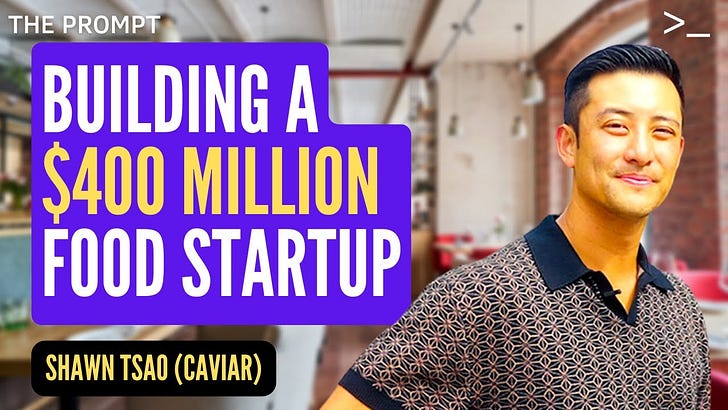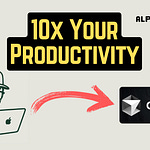Shawn Tsao was the co-founder of Caviar. They sold it to Square for $100 million. DoorDash then bought it from Square for $400 million.
In this episode, expect to learn how the idea of Caviar came from a failed business, their unique partnership strategy that allowed to scale fast, the interesting discovery that made their customers loyal, why he would do it all over again (with a few tweaks), how the Square acquisition went down and much more.
🎧 You can also listen directly to the episode on YouTube, Spotify or Apple Podcasts.
Timestamps
(00:00) Intro
(01:15) Meeting co-founders at UC Berkeley, how they started their first company.
(04:34) Why their first startup struggled, and the decision to pivot.
(07:01) How they shifted from architecture to entrepreneurship
(10:27) The importance of sales skills and persuasion in building a startup team.
(12:56) How surrounding yourself with ambitious people shapes your trajectory
(16:06) The pivot to Caviar, lessons from failure, and building something you’d use yourself.
(22:04) How Caviar partnered with top restaurants
(25:34) The challenges of scaling
(31:20) How Caviar monitored competitors
(34:06) Caviar’s Growth and Retention
(38:07) Square Takes Notice
(46:12) Life after acquisition and DoorDash buyout
(49:04) Lessons and regrets
(52:05) The importance of mental health, networking with other founders
(54:44) What’s Next: Building Restaurants and Investing
(56:12) Routine and Life Balance Post-Exit
(57:04) Outro
💡Conversation Highlights
Questions:
What is Shawn’s backstory?
How did you transition from studying architecture to founding your own company?
How did the Bay Area (Silicon Valley) environment influence your decision to pursue a startup?
That’s crazy about what happened to Groupon. Talk about bad timing. So what impact did Groupon’s struggles have on your first company, Munchi?
What lessons from Munchi did you apply when building Caviar?
So how did you market Caviar to the customers of your partner restaurants?
What was Caviar’s strategy for retaining customers and ensuring their loyalty?
How did Caviar scale its operations across multiple cities?
What about hiring? What was your strategy, and what did you look for in early-stage hires at Caviar?
Food startups are hard because there’s so much competition. So how did you monitor and respond to competition in the food delivery space?
How did Caviar grow, and what steps led to its acquisition by Square?
What was it like emotionally after finalizing the acquisition by Square?
OK, here’s an interesting question. Knowing what you know now, would you start Caviar again if given the chance?
So if you were to rebuild Caviar, what changes would you make based on lessons learned?
What advice would you give founders struggling with the mental and emotional toll of building a company?
Barry: So what’s your backstory?
Shawn: I was raised in Los Angeles; my parents were Chinese immigrants who had me in Japan, where I lived for around five years before we moved to Los Angeles. I then came to the Bay Area to attend the University of California, Berkeley, where I met my future co-founders at a fraternity.
I studied architecture, and in my senior year, a couple of my future Caviar co-founders approached me to start a different company called Munchi, a daily deal company for food, similar to Groupon and LivingSocial. That company got into Y Combinator, but initially, I wasn’t sure about entrepreneurship since I had an offer to work at an architecture firm.
Barry: How did you transition from studying architecture to founding your own company?
Shawn: My friends initially asked for help with marketing materials and sales for Munchi. I could handle the marketing stuff easily since I learned design in school and knew how to use Photoshop and Illustrator. I put together flyers and designed elements for the website. For sales, I just picked up on the fly.
So after graduating in 2011, Munchi went through Y Combinator, but by the end of that year, we were running out of money. It was nearly impossible to raise funds because Groupon was struggling in the markets. That’s when we decided to pivot, and that pivot led to Caviar.
If I hadn’t met my co-founders at UC Berkeley and talked about building a company, I absolutely would have continued on my architecture path. I had committed so much time and money to becoming an architect, starting in high school by taking architecture classes at community college and building my portfolio. I was set on attending architecture school and becoming an architect right after.
In my senior year, my co-founder Jason Wang, who became Caviar’s CEO, convinced me to join Munchi. Jason was pretty persuasive, pointing out that my post-graduation salary as an architect would be around $30,000 a year, which wasn’t really anything. He suggested trying entrepreneurship for a year, as I could always come back to architecture. I had some savings and could stay with my parents if needed, so I took the chance, feeling I could go back to architecture without setting my career back too far.
Barry: How did the Bay Area (Silicon Valley) environment influence your decision to pursue a startup?
Shawn: Being in the Bay Area, specifically San Francisco and Silicon Valley, was crucial. I was exposed to tech news, knew about TechCrunch and Facebook, and absorbed the startup culture through osmosis.
If I had stayed in LA or attended a different school like UCLA or USC, I likely wouldn’t have entered tech. In LA, I might have been drawn to Hollywood’s design industry; on the East Coast, perhaps corporate finance or development.
The Bay Area’s environment, with ambitious people, raised the bar subconsciously, pushing me to compete and improve. Living in a major city surrounds you with driven individuals, elevating your performance, unlike smaller cities where opportunities are limited.
Barry: That’s crazy about what happened to Groupon. Talk about bad timing. So what impact did Groupon’s struggles have on your first company, Munchi?
Shawn: Groupon had a disastrous IPO in 2011; their stock tanked because running the company was costly, with call centers for sales and low retention of restaurants and vendors.
Restaurants offering 50% or 25% off deals lost money, not just from discounts but also from fees paid to services like Groupon, Munchi, and LivingSocial. Vendors found that these deals attracted cheap customers who didn’t return without further discounts, leading to losses and wasted time. This sunk Groupon’s stock, making it impossible for us to raise venture capital for Munchi, as the daily deals industry became very unsexy.
We started Caviar almost immediately after Munchi faltered. In the fall or winter of 2011, we met at a local bar, Bear’s Lair, to discuss our next steps with no money left and no ability to raise funds.
We considered selling Munchi’s assets for pennies or using our remaining runway to figure out something new. We lost a co-founder due to visa issues, but the rest of us decided to try something within two to three months. Food delivery stuck as an idea, leading to Caviar.
Barry: What lessons from Munchi did you apply when building Caviar?
From Munchi, we learned we weren’t using our own product, a red flag for a consumer-facing company. For Caviar, we decided to build something we’d use daily and enjoy creating, even if it failed.
We brainstormed ideas like a peer-to-peer Airbnb for food but settled on food delivery after Y Combinator’s Paul Graham shot down other concepts. Conversations with restaurants, like HRD Coffee Shop, highlighted their need for solutions that made money without discounts, aligning with our goal to solve a real problem we experienced, like wanting specific restaurant food without inconvenient delivery options.
The biggest players then, GrubHub and Seamless, only partnered with restaurants that had their own couriers, often lower-quality ones like pizza places. Many restaurants avoided delivery platforms to protect their brand. My co-founder Jason and I were picky eaters, wanting food from top spots like specific sandwich or pasta places. We targeted these high-quality restaurants with huge followings, knowing they’d attract customers who valued good food and allow us to market without spending much, leveraging their existing popularity.
Barry: So how did you market Caviar to the customers of your partner restaurants?
We did everything possible with restaurant partnerships. I created marketing flyers for restaurants to include with takeout orders and made cheap table stands for dining areas, encouraging customers to order delivery next time. Many restaurants lacked social media or websites, so we built widgets for their sites or created Instagram and Twitter accounts linking back to Caviar.
When restaurants posted about their dishes being available via Caviar, we’d gain thousands of customers quickly.
Barry: What was Caviar’s strategy for retaining customers and ensuring their loyalty?
Listen to this episode with a 7-day free trial
Subscribe to Alpha Bytes to listen to this post and get 7 days of free access to the full post archives.









